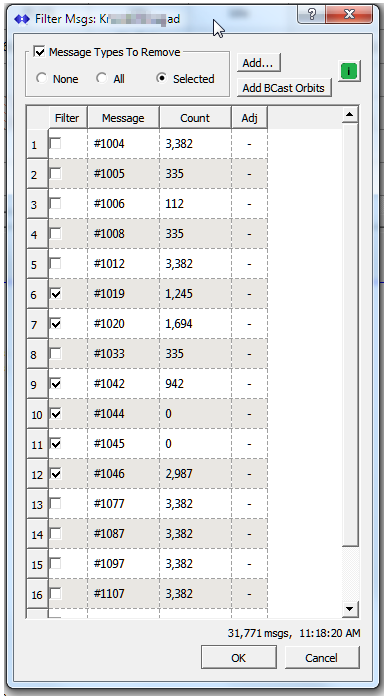The PFAT features are available in the Pro, Basic, editions of SNIP. Lite copies of SNIP share the same code base, but many of these innovative features are disabled in the freely available Lite edition.
Using the PFAT Filter Dialog Control
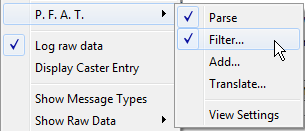 The PFAT Filter control is used to remove selected RTCM3 message types from any Base Station data stream. When a message type is listed in the Filter, it is simply not forwarded on to any NTRIP Clients or to other users in SNIP (such as a PUSH_Out stream). The message type is still parsed and may be used in various navigation and monitoring services. When PFAT Filtering is active, the right-click menu for the stream shows a check mark. Selecting the menu item displays the dialog box. The message stream must be Parsed in order to Filter the messages.
The PFAT Filter control is used to remove selected RTCM3 message types from any Base Station data stream. When a message type is listed in the Filter, it is simply not forwarded on to any NTRIP Clients or to other users in SNIP (such as a PUSH_Out stream). The message type is still parsed and may be used in various navigation and monitoring services. When PFAT Filtering is active, the right-click menu for the stream shows a check mark. Selecting the menu item displays the dialog box. The message stream must be Parsed in order to Filter the messages.
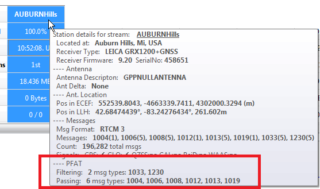 Any RTCM3 message type may be removed by Filtering. However, removing some message types can result in the need to adjust the content of other messages. This adjustment (when needed) is covered in the Translate step of the PFAT process. The list of message types to be filtered is saved in the setting file. When a stream is restarted (such as during the power up stage), any current active message filter for that stream is listed with the normal status information.
Any RTCM3 message type may be removed by Filtering. However, removing some message types can result in the need to adjust the content of other messages. This adjustment (when needed) is covered in the Translate step of the PFAT process. The list of message types to be filtered is saved in the setting file. When a stream is restarted (such as during the power up stage), any current active message filter for that stream is listed with the normal status information.
Hint: The station details (at right) provided in the stream tool tip is a quick way to show if any PFAT Filtering is active for the stream.
A typical Filter Dialog is shown below.
A detailed review of the Filter controls settings can be found here.
As a broad statement, it is best to avoid the need to filter messages by ensuring that only the messages desired are sent by the Base Station in the first place. This also conserves communication bandwidth. Often the ideal set of messages is not possible due to an inability to control that data source, or from diverse needs among the different end users. Filtering allows an easy method to create derivative data stream specifically to meet the needs of your NTRIP Client users.
Typical Uses Cases for Message Filtering
Common uses of the PFAT Filter are described further in the examples below.
Removing Orbital Data
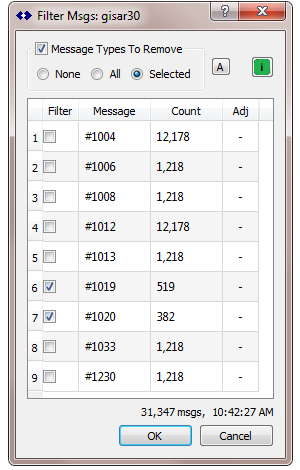 Some Base Station devices provide Broadcast ephemeris messages as a part of their message stream (most do not). Others will provide a single broadcast ephemeris message when each new SV is first tracked above the local horizon. To some operators this represents excess message baggage that is best removed. Other operators may not want to use raw broadcast ephemeris messages, preferring other sources. Still other operators prefer to use the RTCM3EPH stream for all ephemeris messages. The removal of any ephemeris message is easily achieved using Filter settings like those show below.
Some Base Station devices provide Broadcast ephemeris messages as a part of their message stream (most do not). Others will provide a single broadcast ephemeris message when each new SV is first tracked above the local horizon. To some operators this represents excess message baggage that is best removed. Other operators may not want to use raw broadcast ephemeris messages, preferring other sources. Still other operators prefer to use the RTCM3EPH stream for all ephemeris messages. The removal of any ephemeris message is easily achieved using Filter settings like those show below.
Removing Observations for a GNSS type
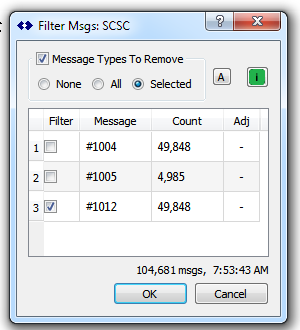 Most Base Stations deployed today provide L1/L2 data about both GPS and GLO type GNSS systems. Other systems, and other signals, are also being deployed as the availability different GNSS signals continues to grow. But if you happen to have a older GNSS rover device that cannot use such data, these innovations are wasted bandwidth from your perspective. By using Filtering, a stream can be created that provides only the messages that are desired. The most common use of this is to remove GLONASS data from a GPS+GLO stream, leaving only the GPS data messages to be sent out (and again, at a reduced use of client bandwidth).
Most Base Stations deployed today provide L1/L2 data about both GPS and GLO type GNSS systems. Other systems, and other signals, are also being deployed as the availability different GNSS signals continues to grow. But if you happen to have a older GNSS rover device that cannot use such data, these innovations are wasted bandwidth from your perspective. By using Filtering, a stream can be created that provides only the messages that are desired. The most common use of this is to remove GLONASS data from a GPS+GLO stream, leaving only the GPS data messages to be sent out (and again, at a reduced use of client bandwidth).
Note that in this example, the remaining GPS observational messages (MT 1004) must also be adjusted with the Translate ability of PFAT to indicate to the rover devices in the field that MT 1004s (and not the MT 1013, the GLO observation messages) are now the last messages in a common measurement epoch. SNIP handles this for you.
Removing “Clutter” Messages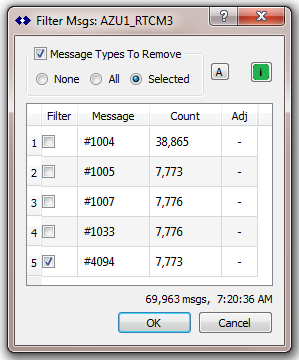
Some Base Stations contain messages that simply are not wanted or needed by the end user community. As an example: in the seismically active southern California region there are many Base Stations that transmit Plate Boundary Observation (PBO) messages every 10 seconds. These are constructed using a private message type (MT 4094 assigned to Trimble). Like any other message type, they can easily be Filtered from the stream.
See Also
- PFAT Add; used for Adding messages to a data stream
- PFAT Translate; used for Translating the messages in a data stream

